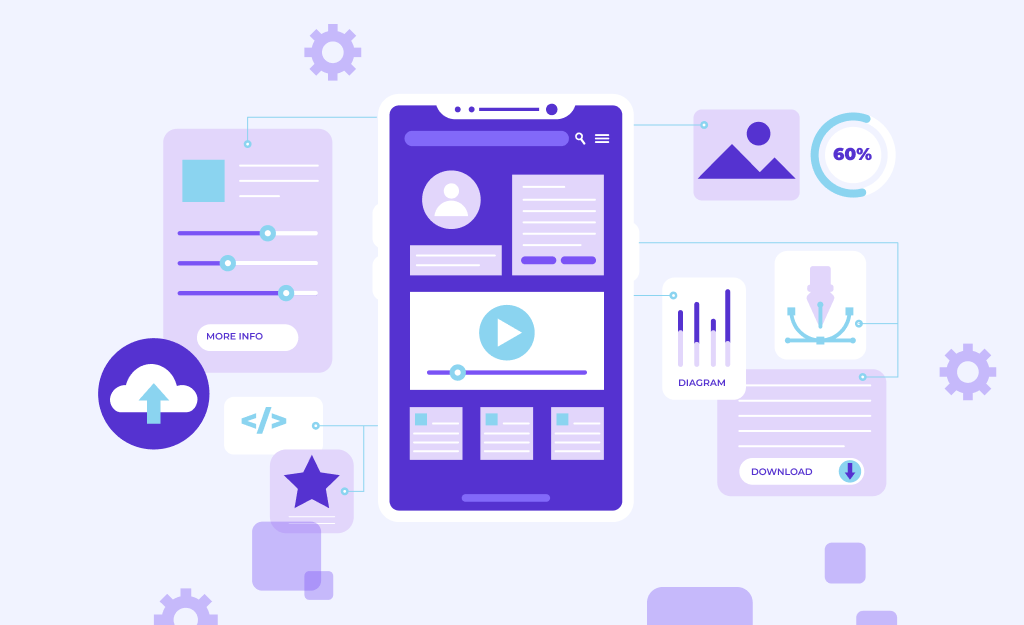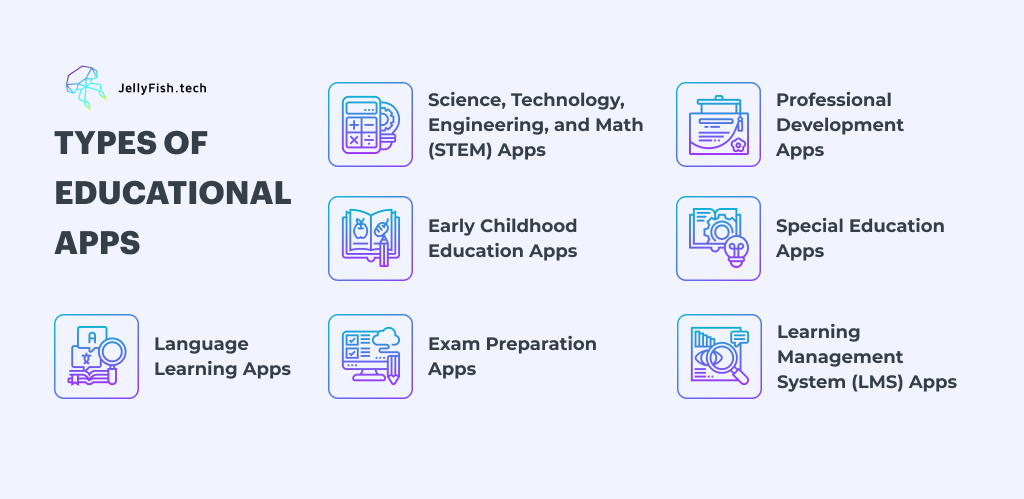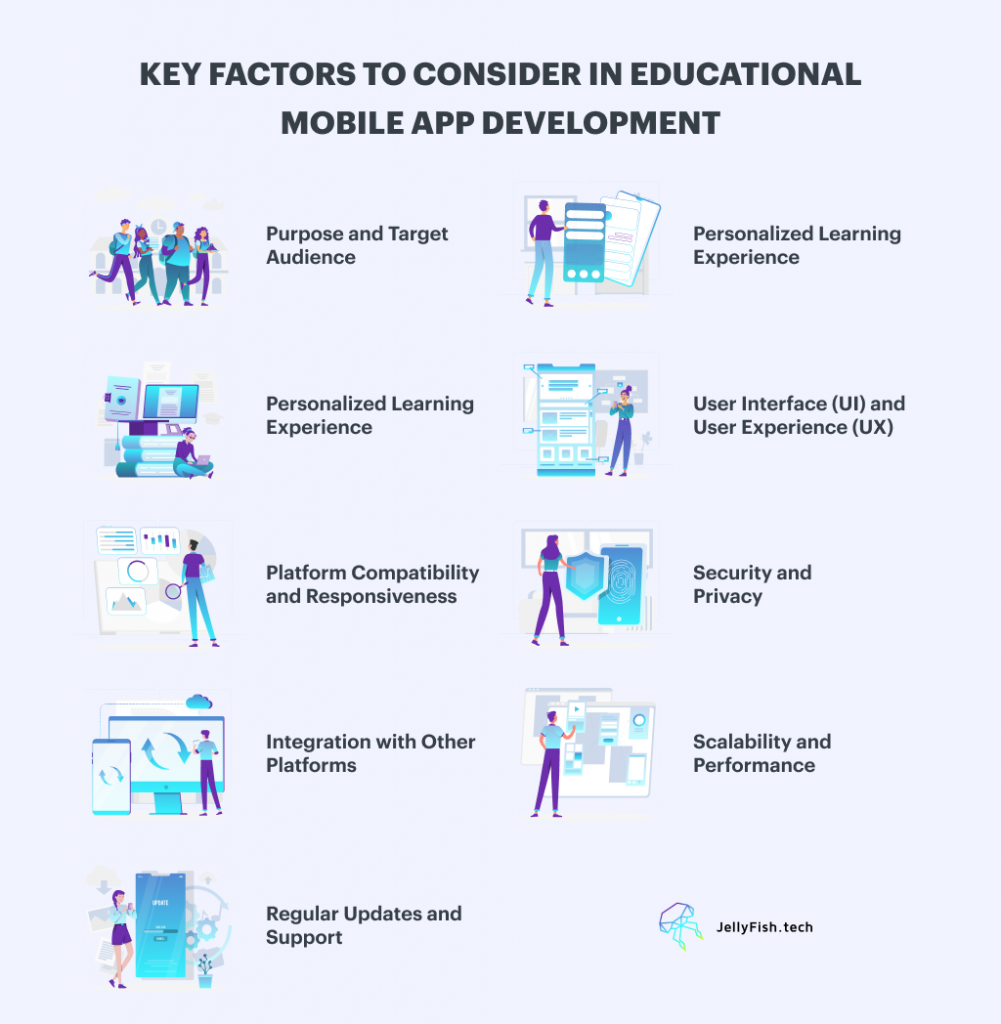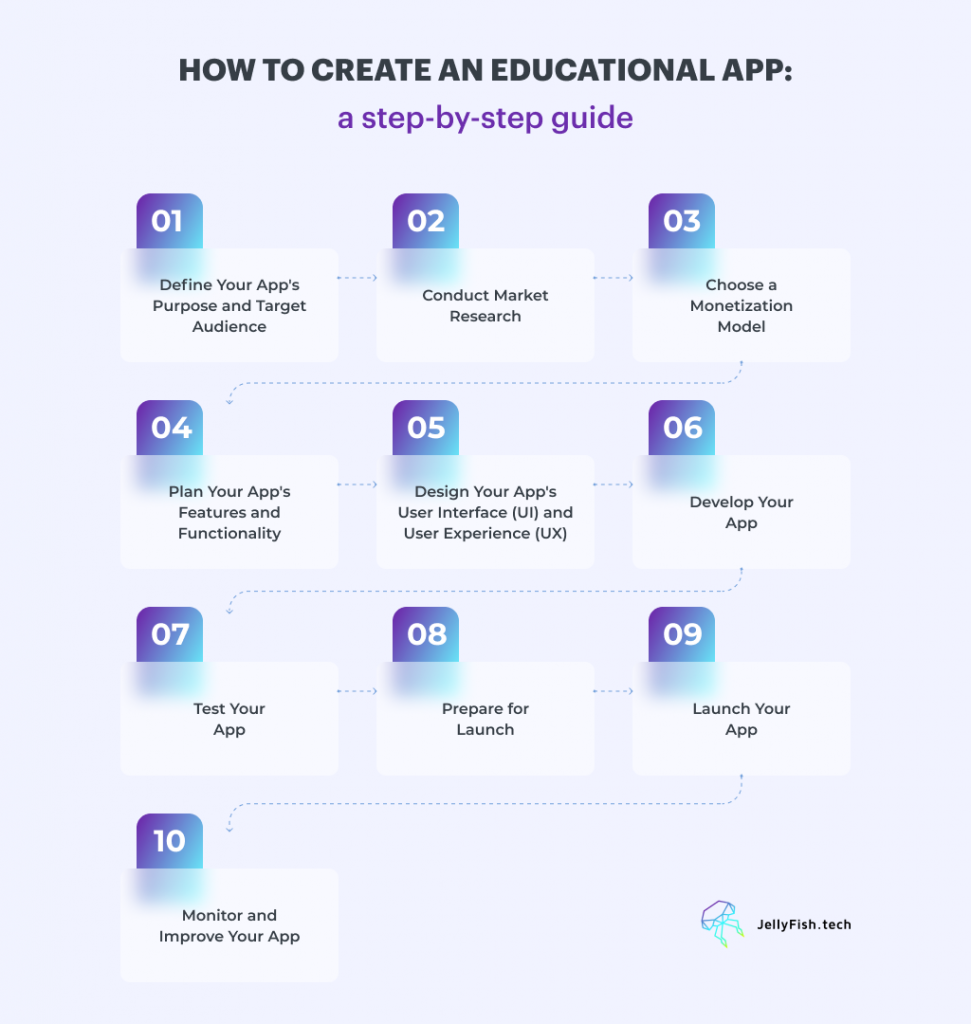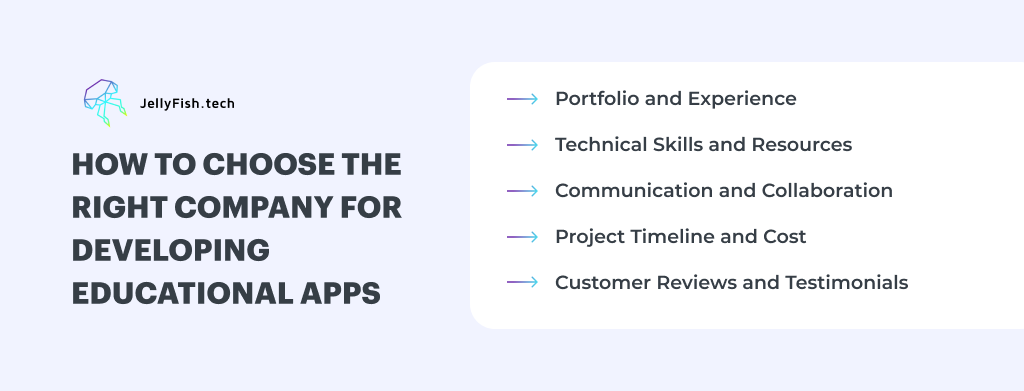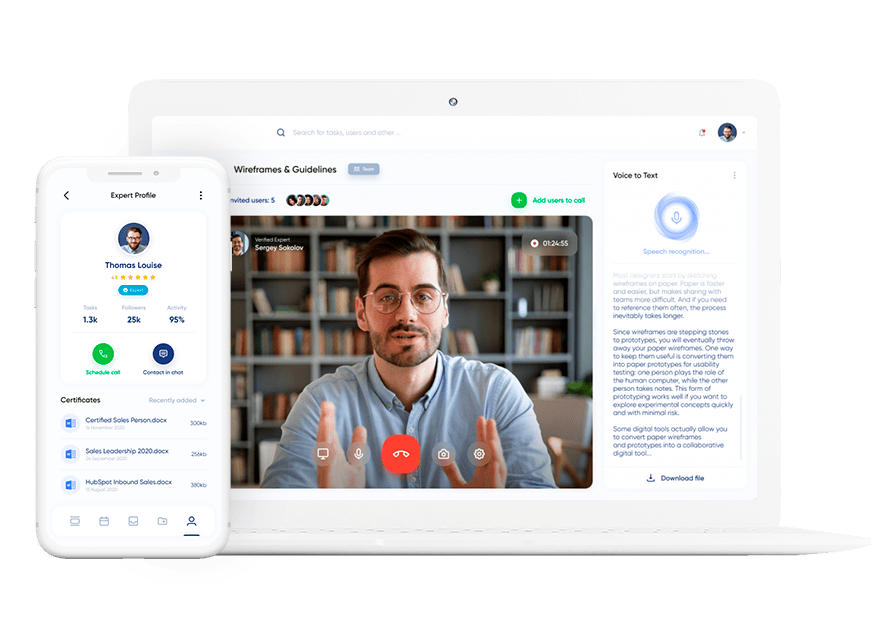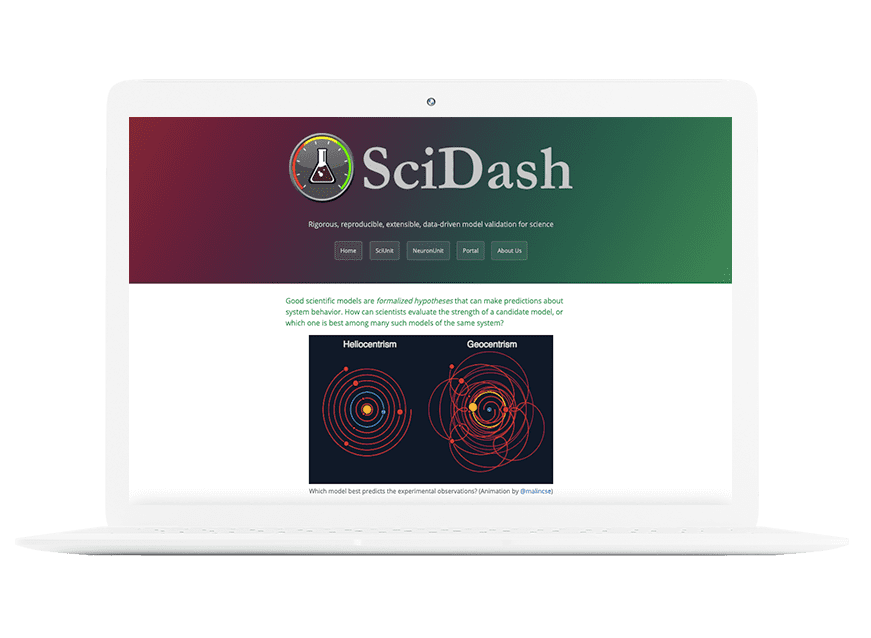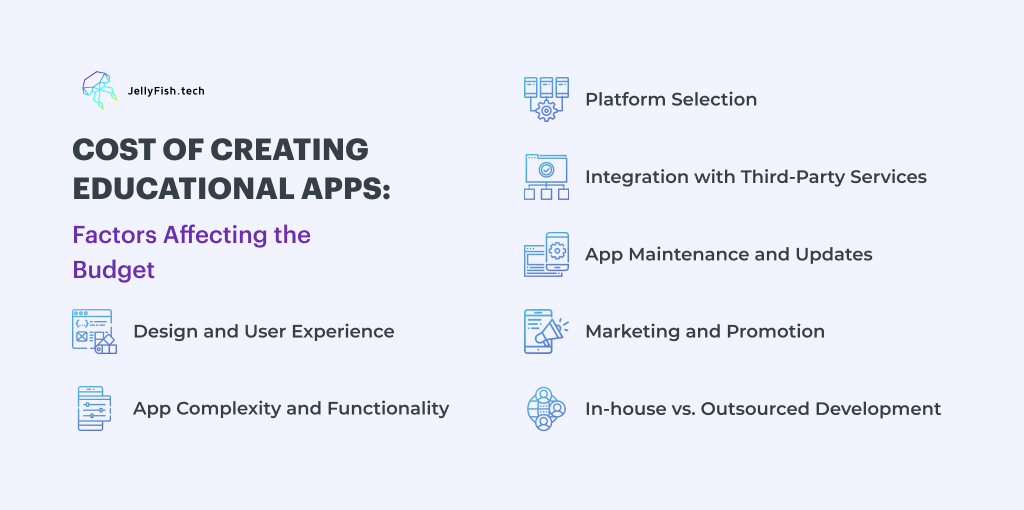
Unlock a World of New Possibilities With Effective E-learning App Development
E-learning software has already revolutionized the way we see education. It offers a wide range of benefits for students or employees needing new knowledge, as well as for businesses and educational organizations looking for more efficient tools. For learners, these apps provide a convenient way to access training materials anytime and anywhere, even with no connection. This means that users can learn on their own time and at their own pace. E-learning apps also give students access to video tutorials, quizzes, training simulations, and other interactive elements that make learning more engaging and effective.
For educational institutions, choosing an e-learning tool as an option for their students is a faster way to deliver knowledge, which even leads to better information retention rates. It is also a win-win strategy for businesses. More and more enterprises are eager to invest in e-learning app development because sharing training materials via such apps requires fewer resources from both employers and their staff.
Today, we will discuss best practices for developing an engaging e-learning mobile app and its benefits for your business. We will also share details about our experience in this area to help you decide on specific requirements for your future custom-made edtech tool and discover ways to implement them.
What Do Users Look For in E-learning Mobile Apps in 2023?
E-learning app development gives organizations an opportunity to create content that captures the attention of learners. Through creative designs, animations and videos, developers can craft an experience that is not only engaging but also encourages lifelong learning by rewarding users for completing courses or tasks.
Propelled by the ever-increasing need for remote training tools and accelerating digital transformation of business, the market for e-learning software maintains steady growth. According to Straits Research, it is expected to reach USD 645 billion by 2030 with a CAGR of 13%. One of the central roles here is also played by the greater adoption of mobile and IoT technologies that contribute to better connectivity and flexibility for remote workers and students.
So what are some of the most successful strategies to follow for creating edtech mobile software in 2023?
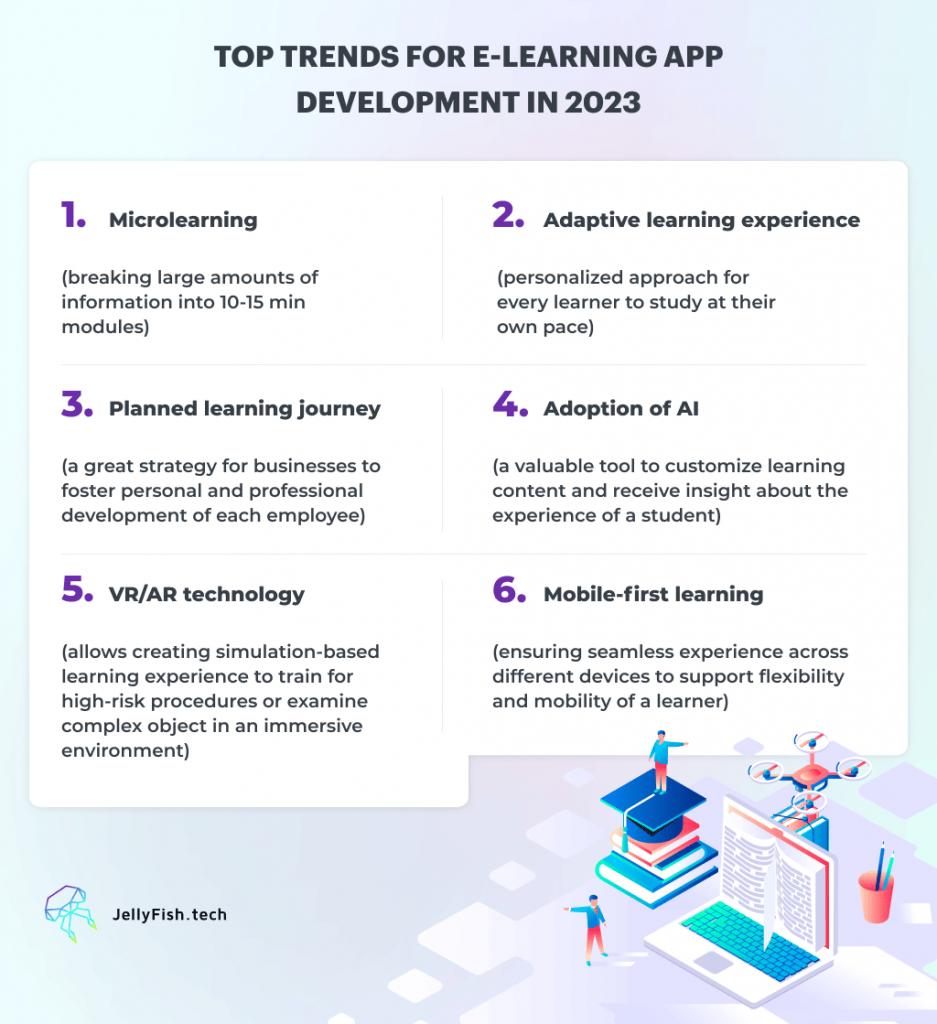
1. Enabling microlearning
This technique essentially means breaking large topics into more manageable modules. This makes it easier for a learner to stay focused in a modern dynamic environment that is oversaturated with information and distractions. Microlearning is built upon spaced repetition — a method that implies providing a person with the same content several times with adequate spaces between lessons.
Such a technique improves long-term comprehension rates and facilitates better engagement with e-learning software. For example, EdApp has proven that microlearning increased the completion rates for one of their modules from 15% to nearly 90%. Moreover, it works even better with on-demand design, when users can identify the spaces between repetitive lessons for themselves. This way, microlearning allows for customization of the studying process and leads to better results, even if a person spends minimum time on a training topic at a time.
2. Focusing on adaptive learning experience
Continuing the topic of customizing the flow of studying, it is important to mention that adaptive learning is at the very core of successful e-learning app development. Do you remember the times when you visited lectures and knew everything that a teacher was telling you about? Or even a worse scenario — when there was a huge gap between your current level of knowledge and the topic that was being discussed during a lesson? To avoid these situations, applications built with an adaptive learning approach in mind use a learner’s preferences, algorithms, and AI to provide them with tailored material that satisfies their unique needs.
Based on adaptive learning, edtech apps can also identify areas where students are struggling to provide them with targeted instructions exactly when they are most needed. All in all, this approach is proven to increase motivation and engagement by creating a more personalized experience than traditional broad-based methods.
3. Building a planned learning journey
This is vital for businesses, as continuous learning is one of the keys to a company’s success. Creating a planned learning journey means building a development plan for an employee that is based on the business strategy. It helps to align personal development goals of a team member with the objectives of an enterprise, fostering leadership and motivation.
Edtech apps that help plan the learning journey can also track the employee’s progress over time, provide different rewards and motivational messages and select relevant content to increase engagement. An excellent idea for such solutions is to include virtual coworking and content co-creation spaces where teams can work together online.
4. Adoption of AI
AI is already being used in many applications as a tool for improving the efficacy of e-learning. By using natural language processing (NLP) technologies, it can help create more engaging content that speaks to learners in their own language. AI-powered digital assistants or chatbots provide constant support for users of edtech software, which gives them relevant feedback whenever they choose to engage in their learning process.
Moreover, AI can be used in such software applications to detect the tonality and sentiment of user interactions with the content. This helps to receive insight into how students feel about their learning experience and how they respond to course material and activities. By detecting subtle changes in tone or sentiment, AI can also serve as a valuable tool to adjust course materials accordingly and ensure that learners remain engaged throughout their journey.
5. Incorporating VR/AR technology
With the help of Virtual and Augmented Reality, learners can be immersed in a simulation-based training experience and get the feeling of a real-life scenario. With a VR headset on, users can learn different movements that would be required in a real situation to improve precision and build muscle memory (e.g. for high-risk procedures like surgeries). On the other hand, AR serves to add elements that overlay a live view through the camera of your device. This technology is a great way to visualize complex objects and learn how to interact with them (e.g. to build a vehicle or any other machine).
VR/AR brings a gamification element to e-learning which makes it far more interactive and efficient. They offer practical ways to learn a topic, so one lesson with software powered by these technologies can be more efficient than dozens of traditional instructions.
6. Ensuring seamless mobile learning
Mobility is crucial for modern learners, it is a new norm. As for one of the leading providers of Information and Communication Technology, Ericsson, by 2028, the average monthly mobile data usage per smartphone is projected to reach 55 GB in North America, 54 GB in South Asia, and 52 GB in Western Europe. Caused by the consequences of the COVID-19 pandemic, the spike in mobile data consumption will be further accelerated by the adoption of 5G technology. This gives us a clear understanding that however complex a software application is, it has to be optimized for mobile usage.
In terms of corporate education, mobile learning is a perfect option to reach remote workers, employees that are always on the go, and those who want to continue studying in their free time. Regardless of the device at hand (PCs, laptops, tablets, smartphones), a learner is provided with the same quality of content across all of them.
Even though there are many aspects to consider during the development of a mobile edtech solution, an experienced team will always help you power your application with the most efficient technologies.

Which Tasks Can Your Business Solve With E-learning Mobile App Development?
There are many signs your company needs a custom-made application for training employees. For example, if your business has an advanced organizational structure and each department needs a separate training course to cover all workflows and tools, universal third-party edtech tools may not meet all your requirements. One more reason to consider the development of a unique e-learning application is the constant introduction of innovations. If you upgrade your procedures on a regular basis and often incorporate new technologies and software solutions to streamline your business processes, your team will benefit from a customizable and scalable edtech platform that can keep up with your demands.
Let’s discuss the goals your organization can achieve with successful e-learning application development.
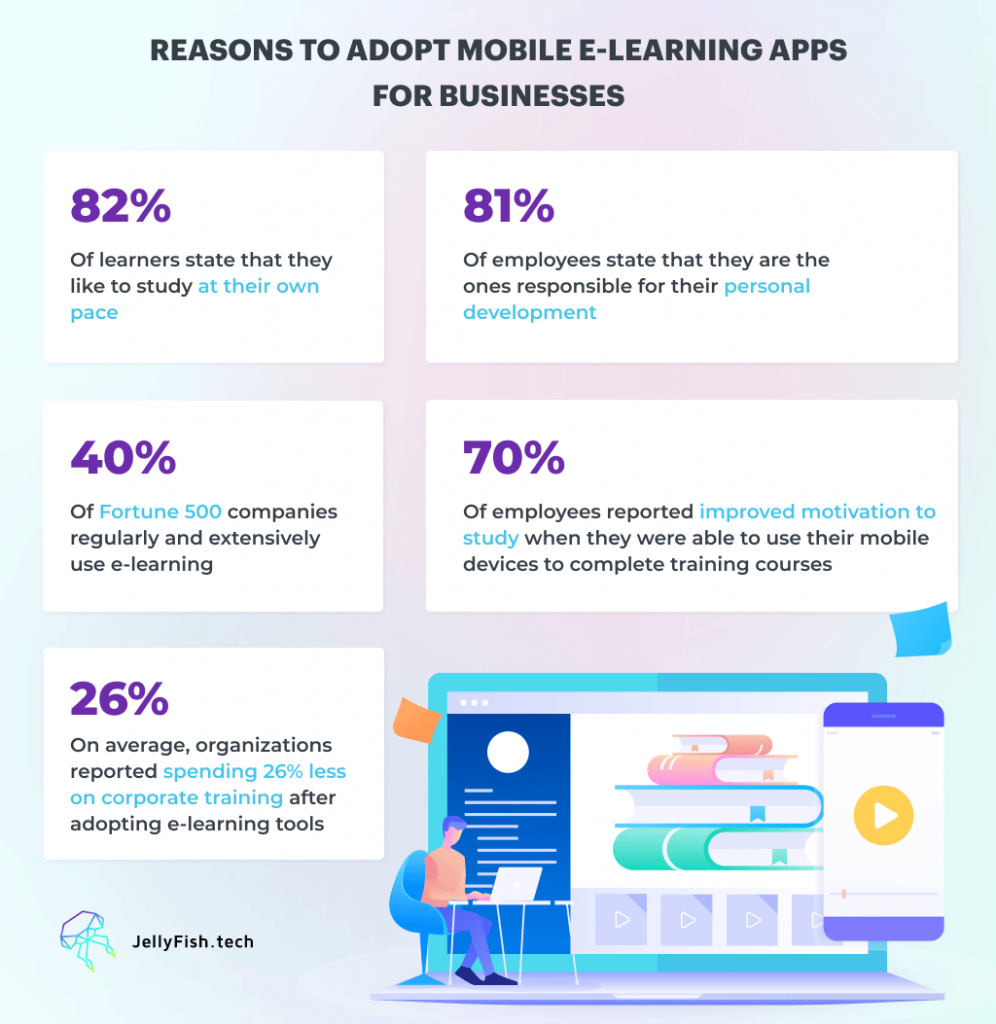
Increased productivity
One of the top benefits of using e-learning apps for businesses lies in better productivity. By deploying mobile e-learning tools, businesses can reduce the amount of time spent in traditional training sessions, allowing employees to spend more time on their actual tasks instead. Additionally, with e-learning, the team is able to access the same training course from any device. This flexibility increases productivity as learners no longer need to be tied down to a physical location to study. Moreover, because the content is readily available online, it eliminates the need for physical materials like books and manuals, which become rudimental and inconvenient in the modern digital world and require additional resources.
Reduced training costs
E-learning apps are often much cheaper to develop and implement than traditional training methods, which presuppose creating a separate course to teach employees any new topic. With such solutions, there is no need to involve external coaches or lecturers and acquire additional learning materials. This way, e-learning app development can save businesses a lot of expenses and bring higher ROI in the long run, while being even more efficient than training in a classroom-like environment.
E-learning mobile software is also great for businesses looking to train their employees with the latest industry knowledge or skillset, as everything the team needs to have access to cutting-edge knowledge is just an internet connection.
Another way that these applications decrease corporate training costs is by saving on business trips. By providing employees with on-demand training materials through an app, enterprises can eliminate travel expenses associated with bringing instructors onsite or vice versa — sending their team members to other facilities for educational conferences and lectures. This type of training reduces time away from work and allows employees to achieve great results whether they are at their workplace or at the comfort of their homes.
Improved employee retention
This may not be the most obvious but definitely a crucial benefit of incorporating a mobile e-learning app into your business training process. Flexibility as well as opportunities for personal and professional development have become paramount for a modern-day employee. By investing in convenient ways for a team to acquire new hard and soft skills, a company actually shows that it is interested in the professional growth of its staff, revealing their true potential and helping on their career journey.
Therefore, adopting edtech software contributes to improving the motivation, engagement, and job satisfaction of employees, so they are more likely to value their position at the company. Moreover, many e-learning mobile solutions give teams access to shared spaces for collaboration. This helps to foster a healthy corporate culture, build communication within and across departments, as well as maintain great team spirit. All by providing a platform for exchanging knowledge and best practices.
Scalability of training solutions
As your business and team grow, more employees will require access to diverse learning materials. In case you choose to develop a custom-made e-learning application for your team, you will not have to worry about spending more on expanding your subscription and service package. Such edtech solutions have great potential for customization and scalability, so the number of users can be increased without additional investment.
Even after the modules of your new e-learning mobile application are built, there is still an opportunity to add new functionality and features, for example, language options. So when your company opens a facility in another country, your new employees will be provided with relevant training tools and materials adapted for them.
Useful Features of the Most Successful Educational Apps for Businesses
It is always a great approach to learn from the best in the industry. Let’s look at the top players in the market of mobile apps for corporate training and go over their key features to know what to bet on during e-learning app development.
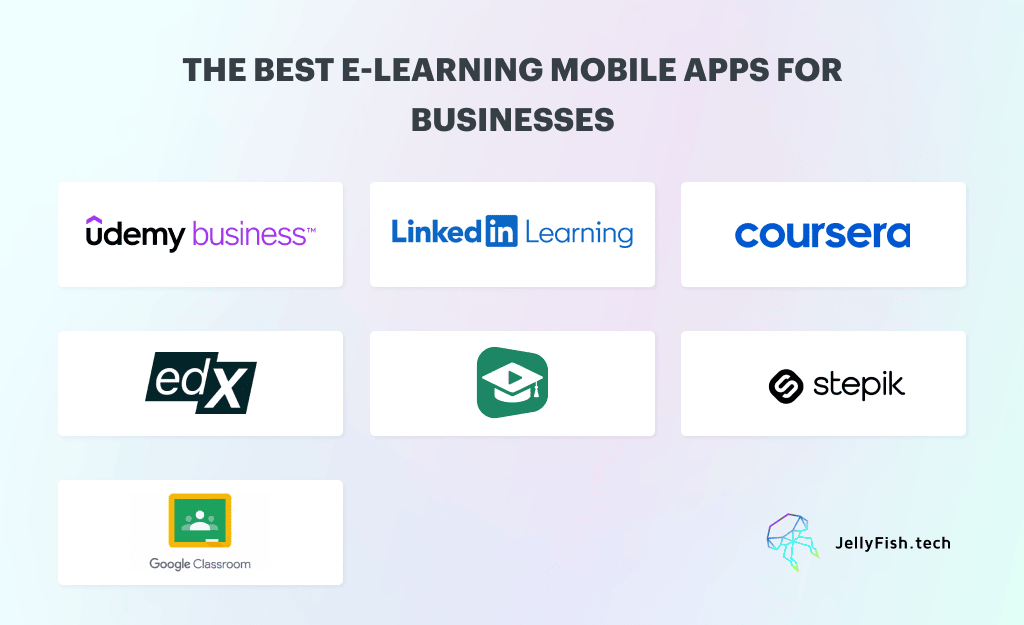
Google Classroom is the ultimate edtech tool for businesses. This platform and its mobile application, available for iOS and Android, help its users create, organize and manage virtual learning activities with ease. The classroom is linked to a Google account, so any changes on either device are saved on both desktop versions of the platform and its mobile app. With Google Classroom, you can assign tasks and monitor the progress of your team from anywhere in the world. You can create online tests, quizzes, and videos to help employees stay engaged with their learning. The platform also allows you to provide quick feedback, which supports an interactive learning environment.
Why is Google Classroom on our list?
- Sends notifications to keep up to date with the team’s progress;
- Allows discussions to foster collaboration and feedback;
- Automatically creates a schedule of planned learning activities in your Google Calendar;
- Meets education standards for security and privacy.
If you are looking for an e-learning app that fits your business needs, considering Stepik is a great idea. Its interface makes it easy for users to create courses, add content, and track the progress of learners in real-time. With Stepik, businesses can create engaging and interactive learning experiences for their employees with just a few clicks. Innovative features of this application also allow companies to measure the success of their learning programs and adjust them as needed.
Why is Stepik on our list?
- Provides users with access to a library of over 15 million pieces of educational content from top universities and other sources;
- Enables integrations with other learning management systems, so enterprises can use it along with other tools for corporate training;
- Lets users download lectures to study offline;
- Provides certificates for completing courses.
EdX is one of the most popular e-learning platforms available today, and for a good reason. With edX, businesses can access a wealth of high-quality course content from some of the world’s best universities and colleges. Its mobile app allows learners to stream or download video content on their Android or iOS devices. Courses on EdX cover a wide range of topics, including business, computer science, data science, and more. And with new materials being added all the time, there’s always something new to learn. Best of all, edX is accredited by many major organizations, so you can be sure that your employees are getting the best education.
Why is EdX on our list?
- Lets learners study bachelor and master-level courses to progress in their careers;
- Allows managers to track learner progress in real time;
- Enables teams to align learning programs with business goals;
- The majority of courses are self-paced and can begin at any time.
Cursa is another excellent e-learning platform and mobile application that offers a wide range of courses. Like edX, it comprises lectures from one of the best educational institutions on a variety of topics. However, one of the things that set Cursa apart is its focus on language learning. This app is free and offers learning materials and tools of different formats to keep its users engaged and focused (videos, discussion forums, articles, text courses, exercises, and more).
Why is Cursa on our list?
- Offers text format of courses for those who comprehend written materials better than videos;
- User-friendly and pleasant UI;
- Has a News Feed feature, where the app suggests courses and articles in categories related to those preferred by a user and recommends the best teachers.
Coursera is one of the most popular e-learning platforms available today. Its mobile app is also a piece of cake to use, hence the rating of 4.7/5 on Google Play and 4.8/5 on App Store. It offers a variety of educational materials provided by experts in their field from the world’s leading universities and companies. This app allows users to acquire job-relevant competencies and earn career credentials.
Why is Coursera on our list?
- Provides skill assessment and gap analysis;
- Contains in-course short evaluations of learner comprehension and knowledge retention;
- Allows students to download videos to study even without an internet connection;
- Offers interactive content for improved engagement and motivation.
LinkedIn Learning is a trusted and sophisticated edtech application for businesses. With professionally curated courses, it provides learners with valuable skills to get ahead of the competition. One of the distinguishing features of LinkedIn Learning is that this platform serves new information in crisp bite-sized videos, so even the busiest of us find it easy to grasp educational material.
Why is LinkedIn Learning on our list?
- Provides personalized recommendations on training courses;
- Offers certificates upon completion of courses that users can then share on their LinkedIn profiles;
- Enables organizations to determine the impact of learning by tracking their employees’ progress in closing skill gaps.
Last but not least, Udemy for Business also gives access to top-rated educational content to upgrade your knowledge in desired areas of business. Highly rated on both App Store and Google Play, its mobile application offers numerous ways for learners to study in modern fast-paced environments.
Why is Udemy for Business on our list?
- Provides various options for e-learning experience (Mini Player and Background Player to multitask while studying, as well as the opportunity to watch video courses on TV via Chromecast);
- Enables setting reminders for learning sessions;
- Offers optimal learning experience with the ability to take quizzes or practice exams on a user’s smartphone.
After analyzing these top-notch e-learning mobile apps, we come to the conclusion that there are several common features that contribute to their success. This is why it is worth paying attention to them and considering implementing them in your future educational platform. Here are some of the features that can bring maximum benefits for meeting the learning needs of your employees:
- Make it possible to save and download training materials for offline use.
- Enable synchronization of your e-learning mobile app with scheduling assistants and calendars of your team.
- Make sure that there is a functionality for sending notifications and reminders to track the processes and keep up with the optimal pace of learning.
- Pay attention to personalization options, so everybody can study on their own time.
- Encourage learners with in-app rewards after the completion of a module or course (additional points, badges, and other gamification elements);
- Ensure that your employees can earn certificates after passing final tests on knowledge comprehension, so they can share their achievements with colleagues, include them in their CVs and show them on their social media profiles.
Would you like to receive expert e-learning app development services to create an interactive platform that can also be featured on the list of leaders? Then leave us a message and the team of Jellyfish.tech will be happy to help you bring your idea to life.
Success Story: Customized E-learning Application Development
As a reliable e-learning mobile app development company, Jellyfish.tech has several edtech projects in its portfolio. Let us share the practical insights we received in the process.
Creating an edtech marketplace
For this project, we selected a team of 2 frontend and 2 backend developers, a project manager, and a QA engineer. The client’s goal was to connect learners and experts on an interactive edtech platform via video calls and text chats.
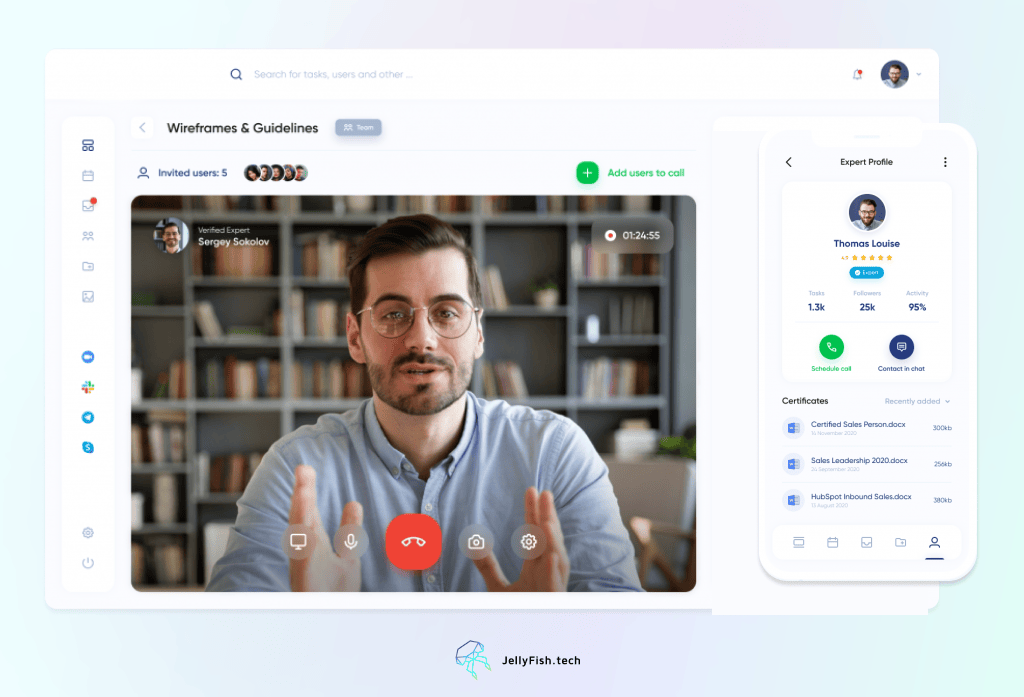
Our team has created a marketplace where experts in various fields offer their tutoring services, connect with students in a few clicks and get paid for their online consultations. We created the MVP of this platform’s mobile application in just 5 weeks. Due to its modular nature, our specialists were able to further expand the marketplace’s functionality on an iterative basis.
By using d3.js in conjunction with Angular and other visualization technologies, we developed an insightful dashboard that allows learners to see up-to-date platform statistics on the best tutors in their desired area of study, their ratings, and the number of students. To monitor the learning process, our team designed a user-friendly task tracker. With its help, users can create and manage assignments, set deadlines and reminders, as well as mark tasks with different statuses (to-do, in progress, completed).
We also powered this edtech marketplace with the following features:
- Integrations with online calendars, secure data storage (Google, Dropbox), and social networks;
- Gamification elements enable learners to earn badges and level up on the platform;
- Fundamental CMS functionality that allows tutors to supplement their tasks with additional materials (videos, manuals, articles) and students to download this content;
- Video-to-text converter to facilitate video instructions.
Due to the user-friendly interface and implementation of innovative technology relevant to e-learning, this software solution has become a flourishing platform for remote education. Learn more details about this project here.

Aspects to Consider When Choosing an E-learning App Development Company
There are thousands of teams offering services for custom e-learning app development. However, because of the fact that this industry is on the rise, there are numerous options to implement the same modules and functionality, so you need to be sure that your idea is in good hands. Having your needs in mind, we have put together a concise list of possible questions to discuss during the meetings with your potential developers.
Relevant experience of the team
If your development contractor already has previous experience with similar software products, they will be aware of the advantages and drawbacks of particular technologies that are used to build customized edtech solutions. This means that the team will be able to provide you with reasonable recommendations and create an application that works for your specific needs.
Development cost
Some e-learning app development companies may encourage you to implement as many features as possible in your future edtech platform. Without respect to your budget needs and without considering whether a specific functionality will be useful for your business or not. This is why it is important to have at least an approximate list of requirements for your project and stick to it, especially if your business is a small or midsize enterprise that may not need a complex e-learning solution. At first, your development partner can create a basic version of your application and then upgrade and expand it with new features if you are satisfied with their services. After all, that is the beauty of custom-made software products.
Possible risks
In case you have any doubts or concerns about developing your own e-learning app, it is always best to communicate them to your potential partner and ask for their feedback. A reliable team will help you avoid common pitfalls in the development process and inform you about some risks that may still be present. An experienced provider of development services will also tell you about practical ways to deal with those risks in the future.
The Cost of E-learning App Development Services
It is no secret that custom development of e-learning software requires a significant investment. But what exactly goes into the cost of building an app?
First, there is the cost of the actual development itself. This includes the budget for hiring the team (developers, designers, project managers and testers), as well as the price of using the necessary tech stack. Then you also have to invest in hosting and maintaining the app. This can encompass server and bandwidth costs, along with other ongoing maintenance expenses. Of course, the budget for e-learning app development mainly depends on:
- The complexity of the functionality that needs to be implemented;
- The size, composition, and location of the development team;
- Platforms for which you want to release your e-learning application;
- The quality of UI/UX design;
- The technologies used for development.
If your budget is limited, a company with relevant expertise in building e-learning solutions is your go-to option to lower the cost. Contact us for a transparent estimation of resources that will be required for your edtech project to make an informed decision.
Summing Up
Developing an effective e-learning application requires a well-thought-out strategy that takes into account both user needs and business goals. By focusing on providing a quality product with interactive content and intuitive features, you will be able to create a pleasing learning experience for your employees or students that will motivate them to become lifelong learners.
Jellyfish.tech is a team of professionals that shares your passion for new knowledge. Our developers have the relevant expertise and skillsets to create an engaging e-learning application for your organization to pave your road to business innovation and growth. Let’s get in touch and make it happen together.




